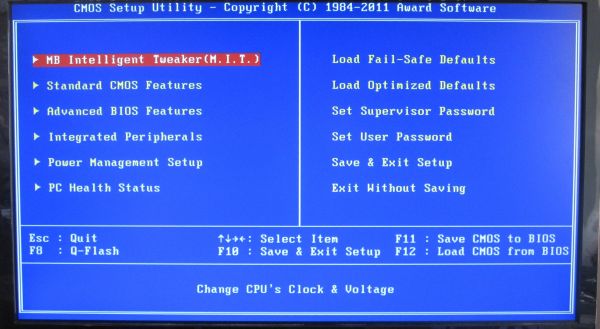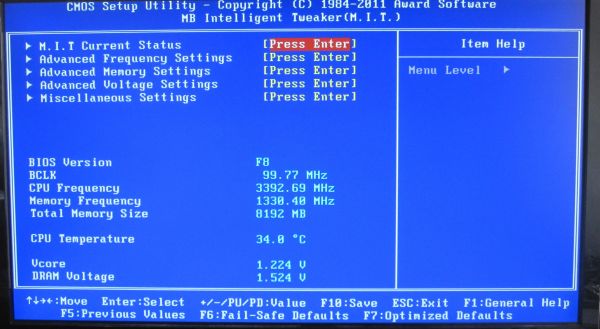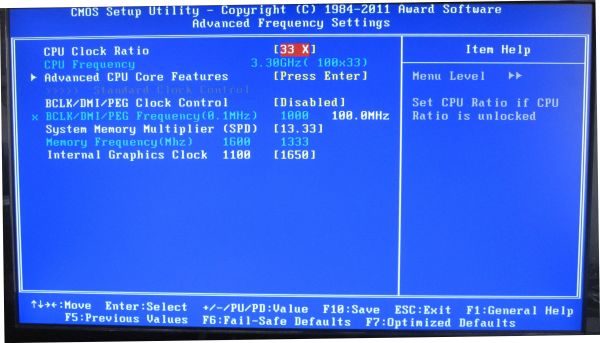H67 – A Triumvirate of Tantalizing Technology
by Ian Cutress on March 27, 2011 6:25 PM EST- Posted in
- Motherboards
- Sandy Bridge
- H67
BIOS
One handy tip for a Gigabyte board is to update to the latest BIOS, then on the next boot, press CTRL + F12. The board will then ask if you wish to swap BIOSes between the two BIOS chips. Select yes, let the board copy them over, then when back in the OS, update the BIOS again. That way, if unbootable settings are chosen and the board needs to use the recovery BIOS, it will be the same version as the one you had before.
While still not on the full graphical UEFI bandwagon yet, Gigabyte’s BIOS-like UEFI system is relatively rock solid and simple to use. In the P67A-UD4 review, I did have a go at Gigabyte for not jumping on the graphical bandwagon, especially when P67 is where the majority of enthusiasts will be headed, but in H67 it is a bit of a different playing field.
The classic system splits the overclocking options into one menu (the MB Intelligent Tweaker), chipset options into another, boot options into another etc. It isn’t a flashy UEFI, but smile, Simple Makes It (a) Lot Easier.
Overclocking
Due to this motherboard having that BCLK adjustable option, I’m splitting up the overclock section into two this time around, one for CPU and the other for the integrated GPU.
CPU Overclocking
The CPU overclock is straightforward – keep bumping up the BCLK until it’s unstable, then scale back a little. In terms of instability, the board made this clear for me by failing to boot into the OS. Take note of what raising the BCLK on a Sandy Bridge chipset actually does – as it raises the base clock of the whole system, everything is increased – CPU frequency, memory, PCIe lanes, SATA ports, USB ports etc. So here you really are limited by the lowest common denominator. If you push the BCLK hard and raise the CPU voltage, it may be pushing something else a bit too hard and lead to failure (like the B2 stepping SATA 3 Gb/s ports).
With my overclock, I knew my chip was capable of 103.5 MHz BCLK (and the memory of 2133 MHz C8, thus plenty of headroom for memory from 1333 MHz C9), so I put that in straight away, adjusting no voltages. The system booted into the OS fine, so I went back and kept raising the BCLK by 0.5 MHz. Instability came in at 105.5 MHz, so I downclocked back to 105.0 MHz, where it was stable. The 105.0 MHz gives the CPU a base clock of 33x105 = 3.465 GHz, and technically an all around 5% rise.
In the 3D Movement Algorithm test, the OC scores were:
- Single Thread: 118.37, up 4.95 % from 112.78
- Multi-Thread: 358.55, up 4.84% from 341.97
GPU Overclocking
One thing did disappoint me regarding GPU Overclocking on this board – there were no presets available to just select and go, like on the ASRock board. Perhaps we may get some when Gigabyte moves to a graphical UEFI.
However, given on previous GPU OC tests, I was aiming for 1800 MHz overclock, and to confirm what I saw on the ASRock H67 board, whereby a large overclock makes the integrated GPU scale back to a thermally more acceptable value. I started the OC at 1400 MHz, no change on any of the voltages.
Up to 1600 MHz in 100 MHz jumps worked fine. At 1700 MHz, when running through Metro2033, the game crashed. In the BIOS you have two graphics voltage options – Graphics Core and Graphics DVID. The DVID option was only changeable when Graphics Core was set to ‘normal’, but I started by raising the Graphics Core voltage. After testing all the way from 1.1 V to 1.2 V (the ASRock reached 1700 MHz with only a +0.05V offset), I switched it to normal and left the Graphics DVID on Auto. In this configuration, Metro2033 completed, but Dirt2 did not. Even adjusting the Graphics DVID to a +0.1V offset didn’t change anything, so I reset them both back to auto and scaled back to 1650 MHz. At 1650 MHz, both games ran very stable at auto voltages.
In the 3D tests, the OC scores were:
- Metro2033: 21.8 FPS, up 23.86% from 17.6 FPS
- Dirt2: 28.1 FPS, up 6.97% from 26.27 FPS




















56 Comments
View All Comments
MrSpadge - Wednesday, March 30, 2011 - link
Well done, Gigabyte! And it's a shame how poorly the others are doing in comparison. I fI wanted high power consumption I could just stick with an old machine or get an AMD..Not wanting to start a bashing / flame war. It's just that in my eyes the exceptional power consumption (especially idle) of the Sandy Bridge + IGP (plus excellent performance) is what makes it really attractive for really many roles.
MrS
trogthefirst - Thursday, March 31, 2011 - link
Actually i was torn between H67/61 and one of those 785G/880G platforms for my aunt recently - non gaming build In the end she needed multi display scalable to possibly 3-4 displays so i went with a cheapo 880G and an $70ish AthlonII X3 With the Surround View feature you could run, with a Radeon GPU up to 4 displays (2 from integrated graphics) and 2 off something like a passively cooled HD 4350/5450 Sounds like a lot of expansion, features, etc for such a cheap platform if u ask me!loimlo - Thursday, March 31, 2011 - link
Dear IanWould you like to share us with Power cumsumption measurement detail?
1. Is it DC or AC draws?
2. How do you measure the watts? From the wall plug by using Kill-a-watt?
3. Did you give not so useful MB's energy-efficiency software like ASRock IES, Gigabyte Energy Saver?
That said, I never had good experience with these softwares, especially Gigabyte one.
ShadowVlican - Thursday, April 7, 2011 - link
did you guys measure total system power consumption, or is that just motherboard? looking to build a HTPC, would love something modern and doesn't eat powertpk911 - Wednesday, April 20, 2011 - link
Intel to release Z68 chipsets in first half of MayMonica Chen, Taipei; Steve Shen, DIGITIMES [Wednesday 20 April 2011]
http://www.digitimes.com/news/a20110419PD212.html
Intel will release its Z68 chipsets in the first half of May, with Gigabyte Technology likely to be the first major motherboard maker to launch Z68-based products as soon as its embargo expires. Gigabyte's offerings will include its top-end GA-Z68X-UD7-B3 model.
Motherboard makers have also reportedly been informed that Intel will focus more on its Z- and H-series chipsets.
The share of P67-series motherboards will begin dropping once the Z68 is launched and the segment will gradually be phased out, with the P-series not being included in Intel's next generation chipsets.
...just a quick update, if I may :)
gsuburban - Sunday, February 12, 2012 - link
I wanted to upgrade from an Asus P5 series board and found most of the P8 boards had no floppy or ide (pata) interface on them. Since I still have 2 great BenQ 1655 DVD recorders, they wouldn't be usable without buying a PCI PATA card. After looking matters over I didn't see much benefit in using up 2 of 6 SATA ports since I have at least 4 hard drives and would be limited on SATA ports etc.I thought it over and discovered the P8H67-V and P8H67-M Pro by Asus still had the ide interface on board. No floppy but at least the IDE was there which would yield 6 SATA ports available without using them for the DVD-Optical.
I use XP Pro still since it does have it's advantages in some areas and not having the floppy drive is the pits as you can't load AHCI drivers via the F6 prompt in setup. I tried all sorts of ideas such as a custom image that included the AHCI drivers etc without success.
The P67 boards are totally fine and they run fast with the right CPU and memory but they are best used with Windows 7. The H67 boards save you about $250 since you don't need a video card, the boards are less than the P67's and with the select models, you get an IDE port which also frees up 2 SATA ports for those who still have IDE devices.
H67 would be my choice for high performance every day computing since the graphics are much improved from the days of G series and price is low, around $105.
I think it's too soon to eliminate the floppy and IDE interface at any rate.